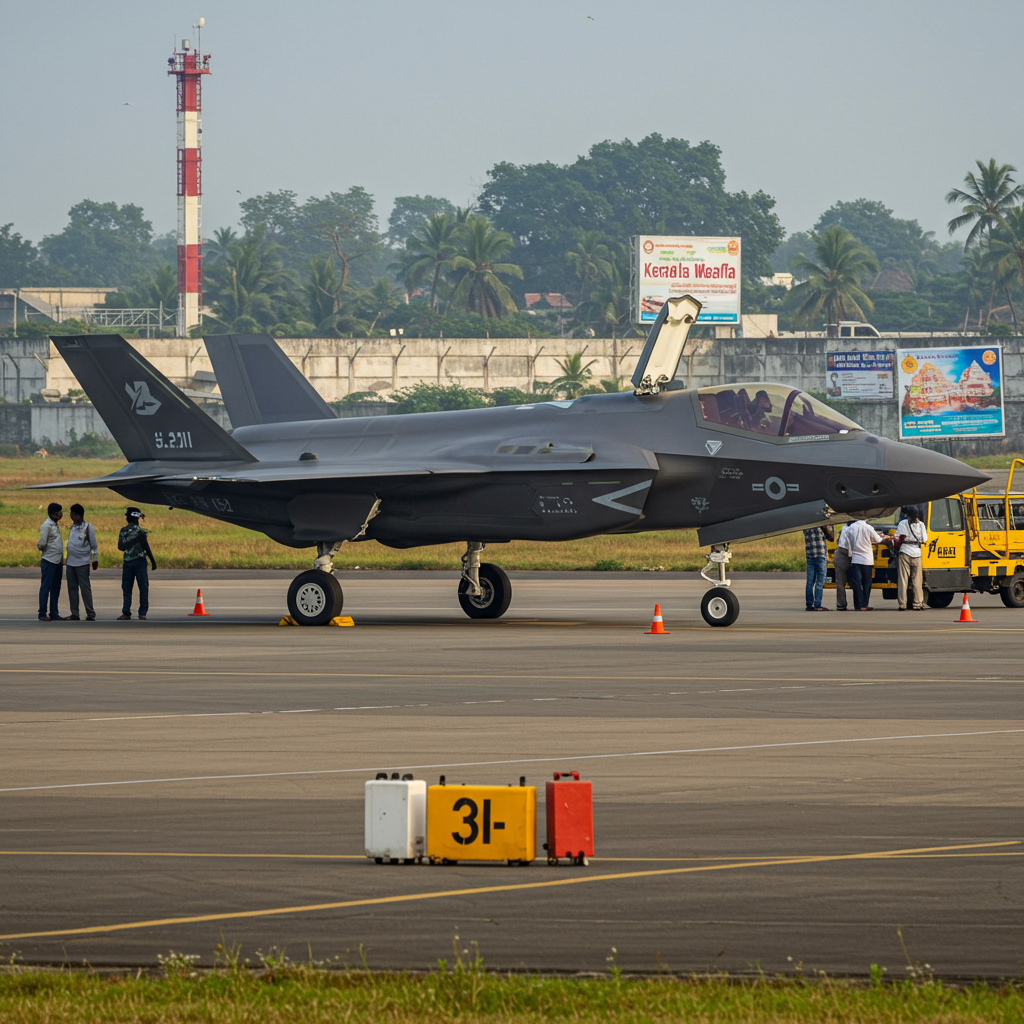A British stealth fighter jet unexpectedly grounded in India has become the unlikely face of a vibrant state’s tourism promotion. For weeks, a sophisticated Royal Navy F-35B Lightning II aircraft has been stranded at Thiruvananthapuram airport in kerala, India. What began as a military incident has remarkably transformed into a viral marketing sensation, showcasing the ingenuity of local tourism efforts. Kerala’s tourism department cleverly leveraged the jet’s presence, turning an unusual technical issue into a global talking point for “God’s own country.”
An Unexpected Arrival
The incident unfolded in mid-June. A state-of-the-art F-35B fighter jet, part of the UK Royal Navy fleet operating from the flagship carrier HMS Prince of Wales, was conducting a sortie over the Arabian Sea off the coast of Kerala. The aircraft, built by Lockheed Martin and valued at an estimated $110 million, encountered adverse weather conditions. This necessitated an emergency diversion and landing at Thiruvananthapuram International Airport.
While the landing itself was safe, the advanced jet subsequently developed a technical snag. This issue proved significant, preventing the aircraft from returning to its carrier or continuing its planned operations. It has remained grounded on the tarmac ever since, sparking considerable curiosity among locals and international observers alike.
For nearly three weeks following the landing, engineering teams from HMS Prince of Wales reportedly attempted repairs on site. However, their efforts did not resolve the issue. The prolonged grounding of such a high-value military asset in a foreign nation presented unique challenges, both logistical and diplomatic.
From Military Hardware to Marketing Star
Seizing upon the widespread attention the grounded jet received, Kerala’s tourism department saw an unconventional opportunity. Instead of ignoring the situation, they chose to embrace it with humor and creativity. An AI-generated image began circulating online. This image depicted the F-35 jet parked serenely on the airport tarmac, surrounded by the iconic coconut palms synonymous with Kerala’s coastal landscapes.
The accompanying caption adopted a lighthearted tone, featuring a quote attributed to the jet itself. The image portrayed the aircraft seemingly giving the state of Kerala a five-star rating, declaring it “an amazing place.” The viral post quoted the jet as saying, “I don’t want to leave. Definitely recommend.” This imaginative approach quickly captured the public’s attention.
According to Biju K., Kerala’s tourism secretary, this campaign was a deliberate strategic move. He described it as one of the most innovative and eye-catching promotions the department had undertaken. The initiative was firmly rooted in good humor and aimed to capitalize on the unexpected global spotlight. Roy Mathew, director of the state’s tourism brand promotion agency, highlighted that the campaign demonstrated how tourism promotion can move beyond traditional government approaches, embracing modern, viral methods.
Leveraging “God’s Own Country” Brand
Kerala has long marketed itself to tourists under the evocative tagline ‘God’s own country.’ The state is celebrated for its stunning natural beauty. This includes its extensive coastline along India’s southwest, tranquil backwaters, lush green hills, and diverse wildlife. Beyond its landscapes, Kerala boasts a rich cultural heritage. This is showcased through its vibrant classical dances, colorful temple festivals, and unique, flavorful cuisine.
This blend of natural attractions and cultural depth makes Kerala one of India’s most popular tourist destinations. Last year alone, the state welcomed an impressive 22.2 million tourists. The unexpected presence of a sophisticated military jet provided an unusual, attention-grabbing hook. It allowed Kerala Tourism to briefly pivot from traditional imagery to something entirely novel and highly shareable, reinforcing the idea that the state is a destination so captivating, even an advanced aircraft finds it hard to leave.
The Technical and Diplomatic Challenge
While the F-35 became a tourism mascot, its prolonged stranding also presented significant technical and diplomatic challenges. The F-35B is a highly sensitive military asset. It is equipped with advanced stealth technology and complex systems designed for short take-off and vertical landing (STOVL) capabilities. Its security and recovery became a priority for both the UK and Indian authorities.
The Indian Air Force offered assistance in the repair and return process. The UK High Commission in India confirmed that they accepted an offer from Indian authorities. This offer involves moving the aircraft to the Maintenance, Repair, and Overhaul (MRO) facility at Thiruvananthapuram airport. This move aims to facilitate repairs and minimize disruption to other airport operations.
Specialist engineering teams from the UK were expected to arrive with necessary equipment to undertake the complex repair work. The British High Commission stated the jet would return to active service after comprehensive repairs and safety checks. Throughout the process, ground teams from the UK have been collaborating closely with Indian authorities to ensure the aircraft’s security and safety.
Security, Oversight, and Expert Perspectives
The security of the high-tech F-35 jet while on foreign soil was a major concern. The aircraft has remained under constant guard by a team of six officers from the Royal Air Force (RAF). This continuous presence ensures the security of its protected technologies and overall integrity.
The incident even drew attention in the UK Parliament. Questions were raised regarding the recovery timeline, the security of the jet’s sensitive technology, and the steps being taken. UK’s Minister for the Armed Forces, Luke Pollard, confirmed in Parliament that an RAF crew was on the ground in Thiruvananthapuram. He stated they were working closely with their Indian counterparts. Pollard praised the “first-class support” provided by the Indian authorities and reiterated that the jet remained under close UK control, with its security guaranteed by the RAF crew.
However, the prolonged delay also prompted expert commentary on the “optics” of the situation. Security experts noted the F-35B’s stranding and the time taken for recovery negatively impacted the image of both the aircraft’s capabilities and the professionalism of the Royal Navy. Dr. Sameer Patil of the Observer Research Foundation highlighted that each day the jet remained grounded damaged credibility. He suggested the engineering issues might be more serious than initially thought. Patil questioned whether standard operating procedures (SOPs) were adequately prepared for such a “worst-case scenario” of a military asset stranded on foreign soil. He described the situation as “very bad PR for a professional navy.”
Social media platforms were awash with memes and jokes related to the jet’s predicament. Humorous posts suggested the jet deserved Indian citizenship or that India should charge rent for its parking space, paid perhaps with the Kohinoor diamond. While adding to the viral nature, this also underscored the unusual public spectacle created by the incident.
Frequently Asked Questions
What happened to the UK F-35 jet stranded in Kerala?
A British Royal Navy F-35B fighter jet made an emergency landing at Thiruvananthapuram airport in Kerala, India, in mid-June. This happened after encountering bad weather and developing a technical snag during a sortie over the Arabian Sea. The sophisticated aircraft has remained grounded there ever since due to the unresolved technical issue.
How did Kerala’s tourism department use the stranded jet for marketing?
Kerala’s tourism department capitalized on the viral attention surrounding the grounded jet by creating a humorous campaign. They shared an AI-generated image showing the F-35 on the tarmac surrounded by palm trees. The image featured a quote attributed to the jet, praising Kerala and stating it didn’t want to leave, positioning the state as an irresistible destination.
What is being done to repair and recover the F-35 jet?
The UK has accepted an offer from Indian authorities to move the F-35 jet to the Maintenance, Repair, and Overhaul (MRO) facility at the airport for repairs. Specialist engineering teams from the UK are expected to arrive with specific equipment needed to fix the issue. The aircraft is under constant guard by six RAF officers and its security is being coordinated with Indian authorities.
A Bizarre Twist of Fate
The saga of the stranded F-35 jet in Kerala offers a fascinating case study. It highlights how an unforeseen military incident can collide with creative local initiatives and global social media trends. While posing technical, logistical, and diplomatic challenges for defence authorities, the grounded aircraft unexpectedly provided a unique platform for Kerala to promote its tourism. The situation, while perhaps frustrating for the Royal Navy, became a fleeting, viral triumph for Indian ingenuity and marketing flair, proving that even the most advanced military hardware can become an unlikely star in the world of travel promotion.
Word Count Check: 1082



